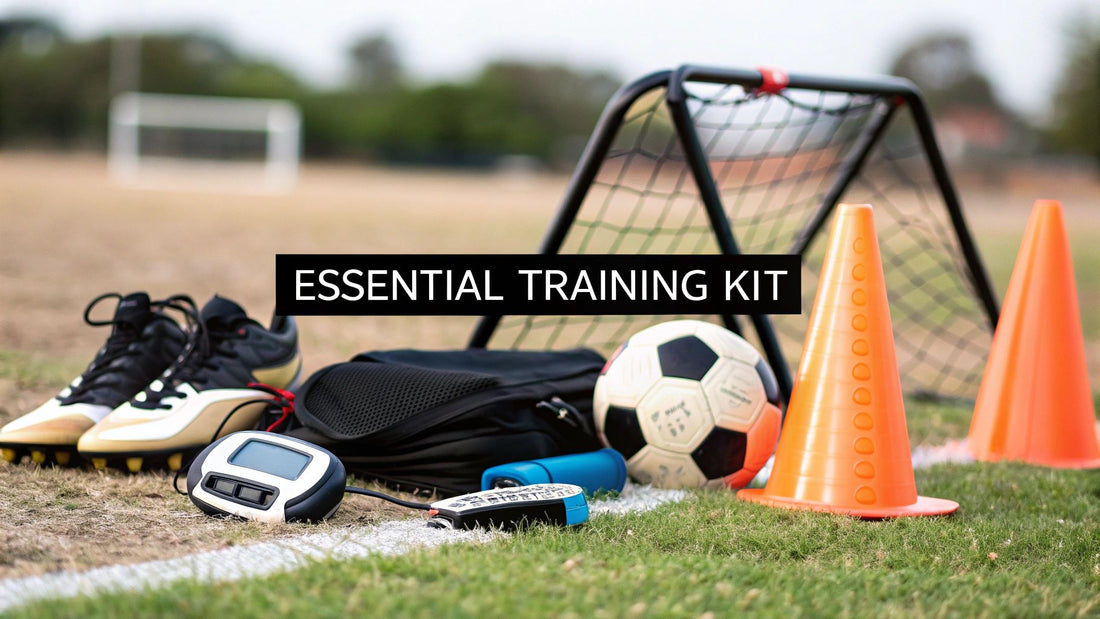A modern football training kit is much more than just a shirt and shorts. It's a complete system of apparel, equipment, and even technology, all designed to make you a better player and keep you safe on the pitch. Think of it as your personal armoury for the training ground, where every piece has a specific, strategic job to do.
What Belongs in a Modern Football Training Kit
Gone are the days when a simple bag with a ball and some cones was enough. Today’s football training kit has evolved into a sophisticated collection that supports players at every level, from Sunday league hopefuls to academy stars. Get the right gear together, and you can turn any standard practice session into a focused opportunity for real skill development.
This evolution reflects how professional the sport has become, even at the grassroots. The market for training gear has exploded, highlighting how seriously players and clubs now take their preparation. For example, the UK football market was valued at around £335 million this year and is set to climb to over £409 million in the next decade. That’s a clear sign people are investing in quality equipment. You can dive into the full UK football market analysis to see these trends for yourself.
A well-assembled training kit is a fundamental investment in your development. It’s not just about looking the part; it's about having the right tools to protect your body, sharpen your skills, and push your physical limits safely.
The Core Categories of a Training Kit
To really understand a modern football kit, it helps to break it down into three main pillars: personal apparel, on-pitch equipment, and performance accessories. Each one plays its own part, but they all work together to help build a better player.
This simple structure shows how a complete kit is built from the ground up.
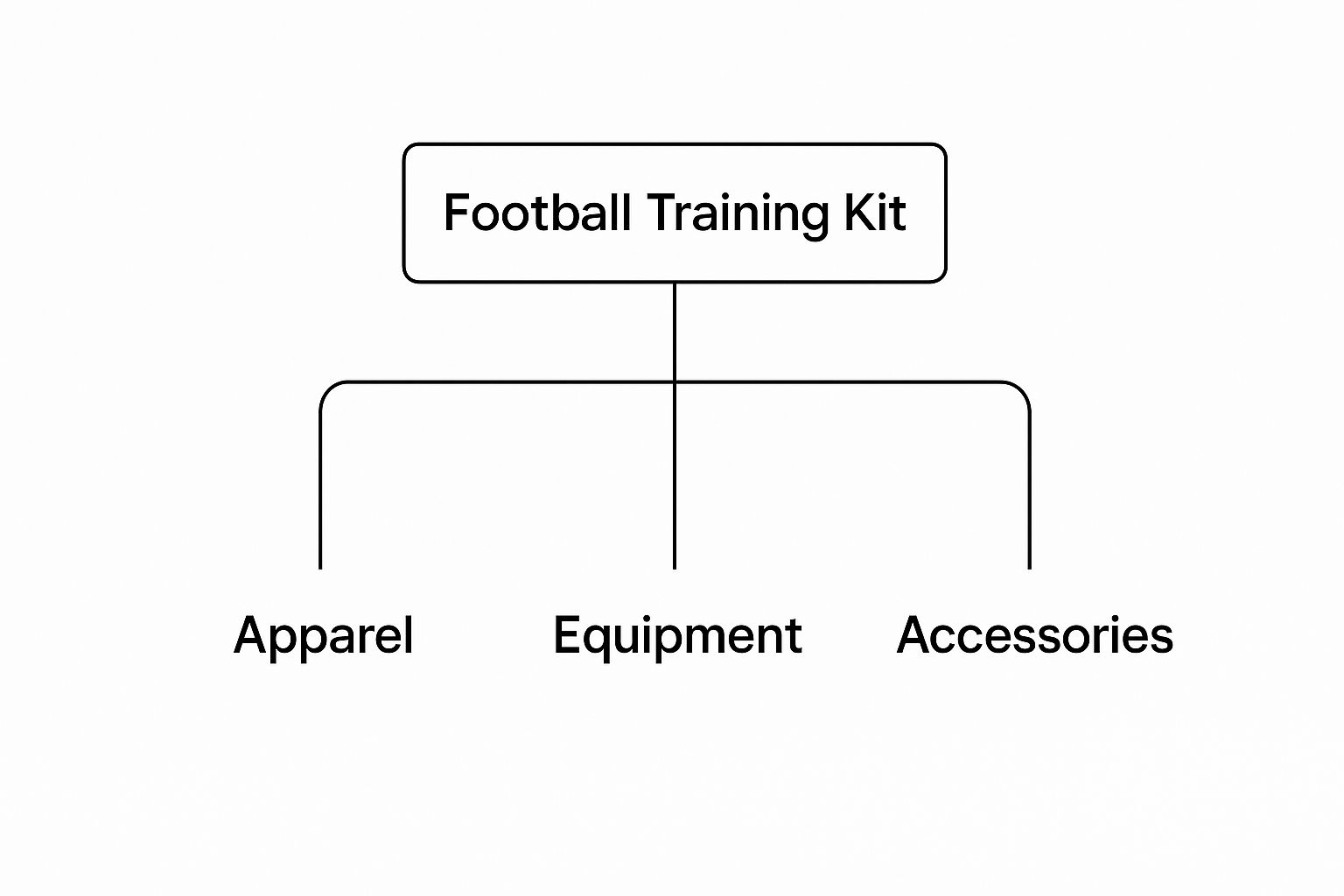
This setup ensures you have everything covered, from the gear that protects you to the tools that make you sharper.
To give you a clearer picture, let's break down what falls into each category and why it is important.
Core Components of a Modern Football Training Kit
| Component Category | Primary Function | Examples |
|---|---|---|
| Personal Apparel | Protection, comfort, and performance during training sessions. | Base layers, training tops, shorts, socks, shin guards, boots. |
| On-Pitch Equipment | Tools used on the training ground to create drills and simulate match scenarios. | Cones, markers, hurdles, poles, goals, rebounders. |
| Performance Accessories | Modern tech and support items that track progress and aid recovery. | GPS trackers, heart rate monitors, foam rollers, resistance bands. |
As you can see, a truly effective kit goes way beyond the basics. It’s a mix of classic essentials and modern innovations that give you a complete system for improvement. In the next sections, we'll dig into each of these categories and detail exactly what you need to look for.
Dressing the Part: Your Personal Gear
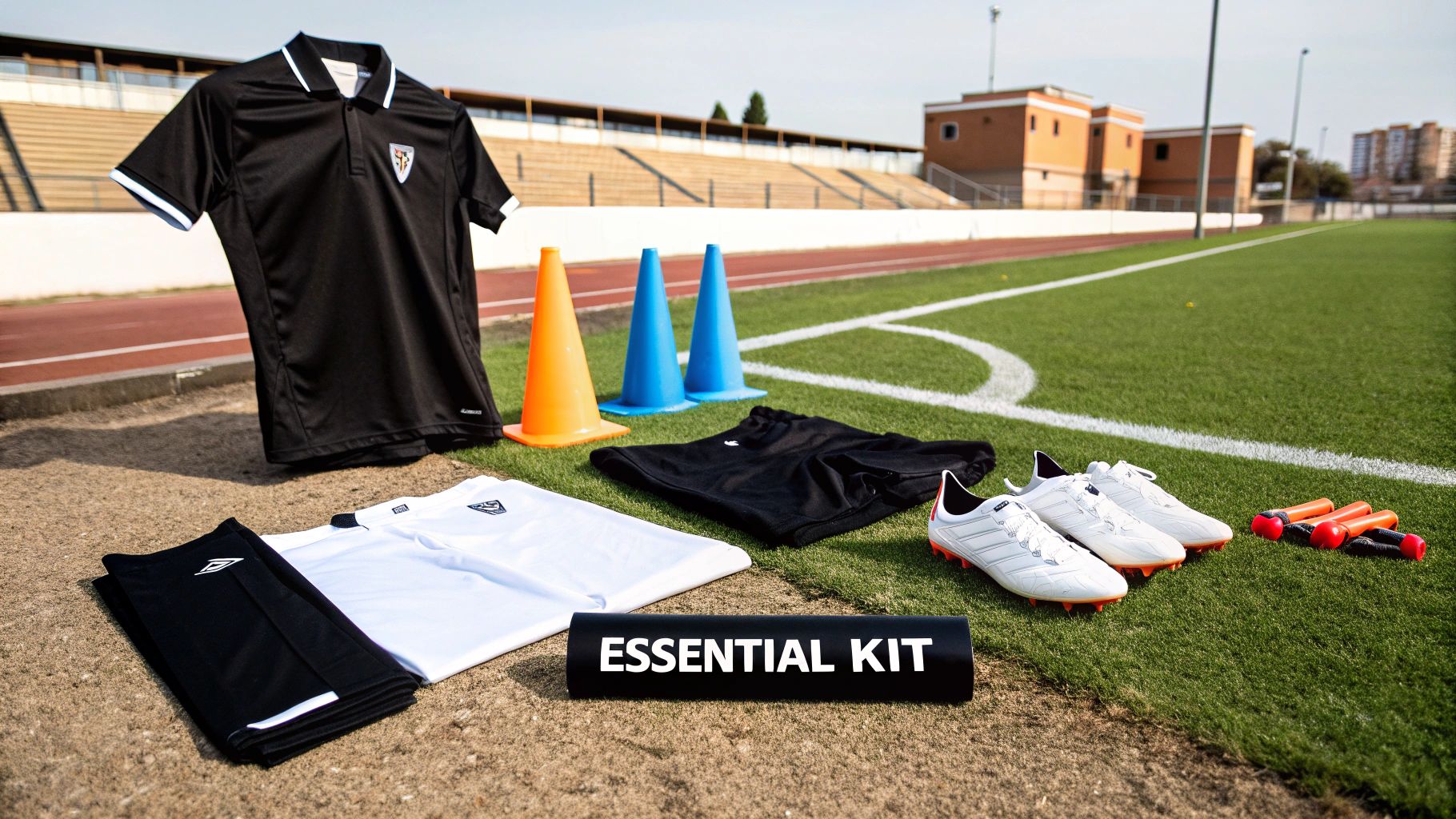 While all the cones, goals, and agility ladders set the stage for a great training session, what you wear is where performance truly begins. Your personal gear has a massive impact on your comfort, safety, and ability to execute skills when it matters. Get this foundation right, and everything else clicks into place.
While all the cones, goals, and agility ladders set the stage for a great training session, what you wear is where performance truly begins. Your personal gear has a massive impact on your comfort, safety, and ability to execute skills when it matters. Get this foundation right, and everything else clicks into place.
First up, and probably the most critical choice you'll make, are your football boots. Your boots are your direct connection to the pitch. Picking the wrong type is like trying to drive a sports car with bicycle tyres—it just doesn't work, and it can even be dangerous. The key is matching your boot’s soleplate to the surface you play on most often.
- Firm Ground (FG): These are the all-rounders. Designed with moulded plastic or rubber studs, they're perfect for the typical dry, natural grass pitches most of us play on. They give you a brilliant balance of grip and freedom to move.
- Soft Ground (SG): When the heavens open and the pitch turns into a mud bath, you need SG boots. These have longer, often metal-tipped, screw-in studs that dig deep for maximum traction, stopping you from sliding all over the place.
- Artificial Grass (AG/TF): Built for modern 3G or 4G surfaces, these boots feature lots of smaller, hollowed-out or rubber studs. This design spreads your weight evenly, taking the strain off your joints and reducing the risk of injury.
Protection and Support Essentials
Next on the non-negotiable list: shin guards. A stray tackle or a misplaced kick can happen in a split second during any drill. A solid pair of shin guards is the only thing standing between your shin and a nasty impact injury. Find a pair that fits snugly and comfortably without restricting your movement.
Beyond the shin guards, don't overlook your socks. A good pair of football socks does more than just hold your guards in place. They provide extra cushioning in high-impact zones like the heel and ball of your foot, offer arch support, and are made from materials that wick sweat away. This keeps your feet dry and dramatically cuts down the risk of blisters during a tough session.
Your personal gear is an investment in your performance and your well-being. Opting for quality materials and the correct fit isn't just about comfort—it's about giving yourself the best possible chance to train effectively and safely.
The Inner Layer Game Changers
Not long ago, advanced fabric technology was something only the elite pros had access to. Now, it's a standard part of modern training kits. The UK football kits market is flooded with gear designed for peak performance, which is great news for players at every level. You can see just how much these materials are shaping the industry in this in-depth football kits market report.
This is where base layers and compression wear really shine.
- Base Layers: These tight-fitting tops and bottoms are worn underneath your main training kit. They are masters of regulating body temperature. By wicking moisture away from your skin, they keep you cool and dry when it's hot and add a layer of warmth when it's cold.
- Compression Wear: This gear fits like a second skin, applying gentle pressure to your muscles. The theory is that this improves blood flow, gives your muscles extra support during hard work, and can even help reduce soreness, speeding up your recovery between sessions.
Investing in quality apparel from specialists like SoccerWares means you’re getting gear that works as hard as you do. The right fit and fabrics aren't just a small detail; they make a real, tangible difference, turning your personal kit into a genuine performance booster.
Equipping the Pitch for Peak Performance
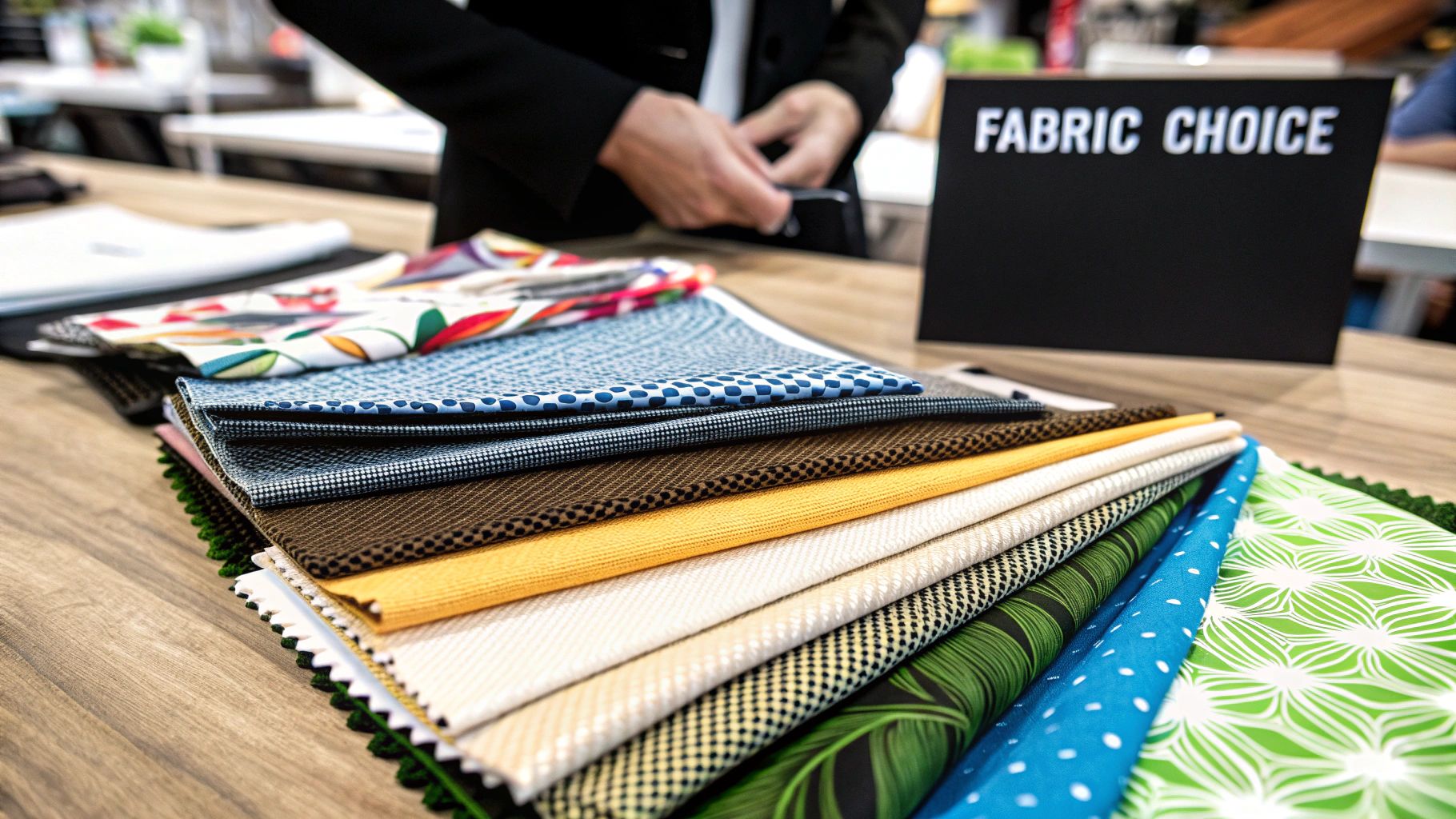
While your personal gear gets you ready for action, a truly effective training session needs more. It's about turning an ordinary patch of grass into a dynamic workshop where skills are forged and refined. The shared, on-pitch equipment is what provides the structure for drills that build technique, intelligence, and athleticism.
Think of these items as the vocabulary of your training session. The more tools you have, the more sophisticated and targeted your practice can become. These pieces are an essential part of any serious football training kit.
The Foundations of Skill Development
Naturally, the most fundamental piece of kit is the football itself. For any structured training, it’s wise to use footballs that match the age and level of your players. A standard size 5 ball is what you'll see for players aged 14 and up. For youth players aged 9-13, a size 4 is ideal—it lets them develop proper control without being hampered by a ball that's too big or heavy.
Beyond the ball, agility equipment forms the backbone of drills focused on speed, footwork, and co-ordination. These are the tools that help players truly master their movement on the pitch.
- Cones and Markers: These are the ultimate multi-purpose tools. You can use them to set up dribbling slaloms, mark out possession boxes, or define boundaries for small-sided games. They're incredibly simple but absolutely essential for organising space.
- Agility Hurdles: Small, lightweight hurdles are fantastic for developing explosive power and quick feet. Drills like the classic "wickets drill" force players to lift their knees and perfect their running mechanics for that burst of acceleration.
- Agility Ladders: Ladders are brilliant for hammering home foot speed, co-ordination, and rhythm. Running through various patterns teaches players to make quick, precise steps—a skill that’s vital when navigating tight situations in a match.
The right on-pitch equipment doesn't just make training look professional; it provides the specific challenges needed to isolate and improve individual skills. It's about creating controlled scenarios that replicate the chaos of a real match.
Advanced Tools for Sharpening Technique
Once you've got the basics of movement covered, larger equipment comes into play to sharpen more complex skills like shooting and passing. These tools are all about giving players instant feedback and allowing for the high-repetition practice that builds muscle memory.
Portable training goals are a complete game-changer for any session. You can set them up anywhere, letting you run shooting drills or small-sided games without needing a full-sized pitch. This is fantastic for sharpening finishing ability, as it forces players to aim for smaller targets, often under pressure.
Another invaluable tool is a football rebounder. A rebounder acts like a training partner that never gets tired. It’s perfect for solo practice, helping you master your first touch, passing accuracy, and volleying technique by consistently returning the ball at different speeds and angles. A quality rebounder can dramatically increase the number of touches a player gets in a session, accelerating their development.
At SoccerWares, we stock a wide range of on-pitch tools, from agility hurdles and ladders to pop-up goals. Our selection is curated to help you build a comprehensive training environment.
Unlocking Your Potential with Training Technology
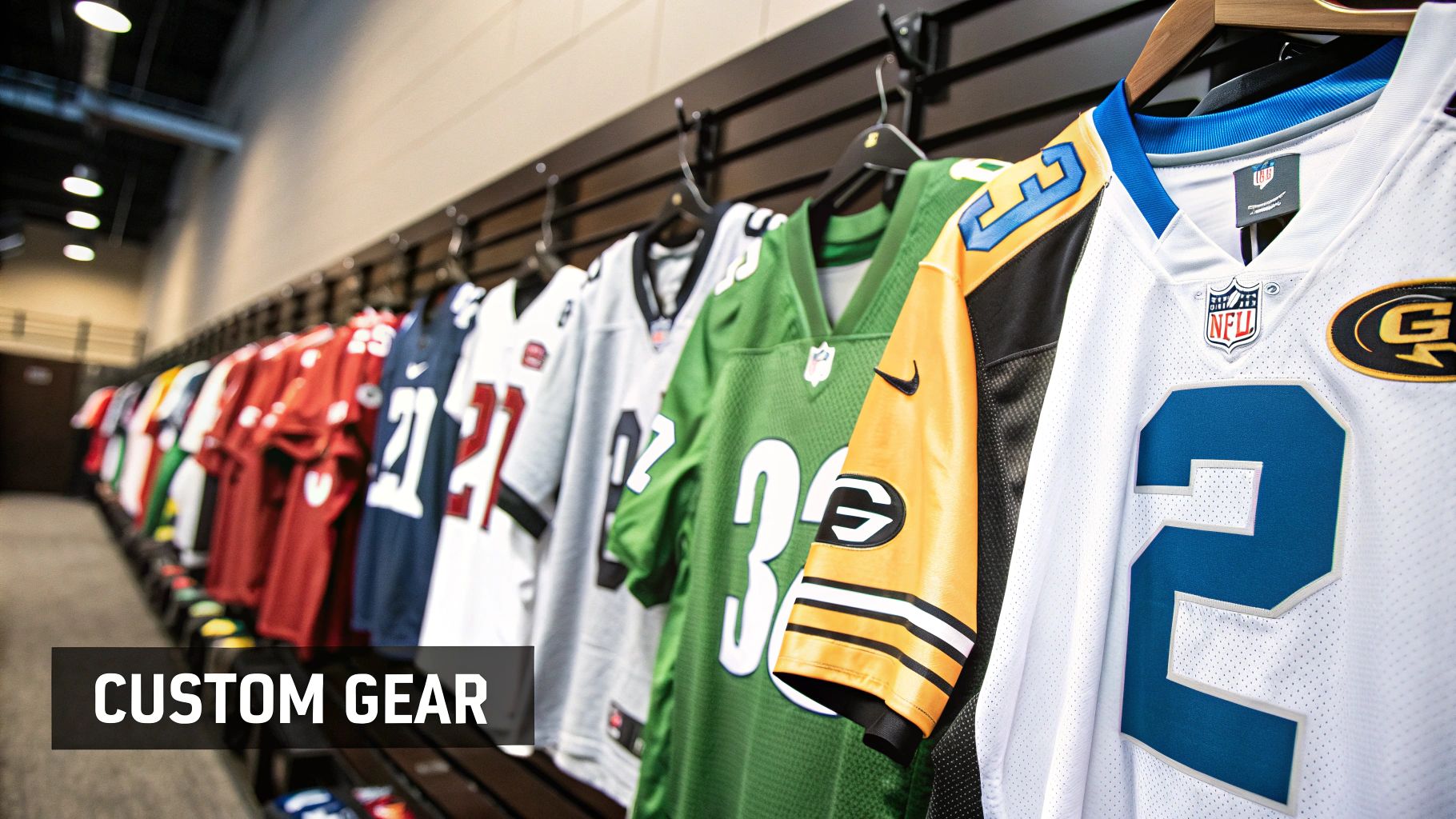
Welcome to the future of football, where data has become just as important as drills. Technology is transforming training sessions from simple kickabouts into incredibly detailed performance analyses. For any ambitious player, these smart tools are no longer reserved for the pros; they're accessible, insightful additions to any serious football training kit.
The growth in this area has been nothing short of remarkable. The global market for football training equipment was recently valued at around £1.2 billion and is projected to hit nearly £2.2 billion within the next eight years. This surge is being driven by clubs and academies investing heavily in data-driven methods, with things like wearable sensors and GPS trackers becoming commonplace. You can explore more about these trends and the booming football equipment market to see just how much tech is shaping player development.
Think of this technology as your own personal performance dashboard. It gives you and your coaches a clear, unbiased look at what’s really happening on the pitch, moving beyond guesswork and gut feelings.
Demystifying Wearable Tech
The most common piece of training tech you'll see these days is the GPS tracker. Tucked into a specialised vest worn under or over your training top, this small device is an absolute powerhouse of information. At its core, it simply tracks your every move during a session, collecting data on the metrics that matter.
These trackers measure a whole range of stats, giving you a complete picture of your physical output.
- Total Distance Covered: See exactly how much ground you cover during a drill or a small-sided game.
- Sprint Speed: Record your maximum velocity to track real improvements in your explosive pace.
- Heat Maps: Get a visual of where you spend most of your time on the pitch, highlighting your positioning and work rate.
- Player Load: This is a key metric. It combines your accelerations, decelerations, and changes of direction to measure your overall intensity.
This data is invaluable. A coach can use it to manage your workload properly, ensuring you’re pushed hard enough to improve but not so hard that you risk injury or burnout. For you, the player, it offers concrete proof of your hard work and shines a light on specific areas that need improvement.
Technology in training isn't about replacing traditional coaching; it’s about enhancing it. It provides objective data that empowers both players and coaches to make smarter, more informed decisions about development.
Smart Equipment for Smarter Practice
Beyond wearables, technology is now being built directly into the equipment itself. Imagine a football that gives you instant feedback on your kicking technique. That's a reality now. AI-enhanced footballs can analyse the spin, speed, and launch angle of your shot, sending all that data straight to an app on your phone.
This allows for incredibly focused practice. Instead of just guessing why that shot went wide, you get immediate, actionable insights to help you adjust your technique right there on the spot. It’s like having a personal skills coach with you for every single kick. These advancements make technology a vital part of the kit for any player looking to find that competitive edge.
How to Choose and Maintain Your Kit
Investing in your football training kit isn't just about buying gear; it's about making smart choices that actually help you improve. What a semi-pro player needs to prepare for a tough season is worlds away from what a youngster just kicking a ball for the first time requires. Your level, budget, and what you’re trying to achieve on the pitch should guide every purchase.
For a beginner, the focus is simple: safety and fundamentals. That means getting a solid pair of boots suited for the surface they play on most, along with a comfortable, protective pair of shin guards. These are the non-negotiables. Getting the ball right is also hugely important for a young player's development. If you want to get into the details, you can learn more about the specifics of a training football size 5 and see why it’s the standard for anyone aged 14 and up.
An intermediate or advanced player, on the other hand, is looking for that extra edge. This is where you might invest in specialised gear like a rebounder from SoccerWares to sharpen that first touch, or even a GPS tracker to get a real look at your physical output during a session. The key is to be honest with yourself about what will genuinely push you forward.
Making Your Gear Last
Once you’ve got your kit sorted, looking after it properly is vital. A little care goes a long, long way, saving you money and ensuring your equipment performs when you need it to. Neglecting your gear is like letting a finely-tuned guitar fall out of tune—it just won’t deliver.
Follow these straightforward steps, and your kit will stay in top condition:
- Boot Care: After every session, get the mud and grass off your boots with a brush and a damp cloth. Stuffing them with newspaper is an old-school trick that works wonders—it helps them dry naturally and keep their shape. Never stick them on a radiator; direct heat will crack the material and make them brittle.
- Apparel Washing: Always wash your technical gear—like base layers and training tops—on a cold wash. This is crucial: avoid fabric softeners. They clog up the pores in the high-tech fabric and ruin its ability to wick sweat away. Let these items air-dry to preserve their elasticity and fit.
- Equipment Storage: Keep your footballs properly inflated and store them where they won't be exposed to extreme heat or cold. For bigger pieces of kit like portable goals or rebounders, give them a wipe-down and store them in a dry place to prevent rust and material breakdown.
Looking after your football training kit is just as important as the training itself. Well-maintained gear doesn’t just last longer—it performs better, ensuring you’re always ready for your next session.
Your Ultimate Training Kit Checklist
A proper football training kit is one of the smartest investments you can make in your game. It’s not just about looking the part—it’s about having the right tools to build confidence, sharpen your skills, and even get hard data on your performance. Every single item, from what you wear to the gear you use on the pitch, plays a specific role.
To make this simple, we've broken it all down into a clear checklist. It's organised by player level, so you can pinpoint exactly what you need for where you are right now and where you want to go.
Youth and Beginner Essentials
For new players just starting out, the focus is simple: safety, fundamentals, and fun. You want to build a love for the game, and that starts with having the basic protection and gear to learn core skills without any fuss.
If you're getting a young player started, our detailed guide on a kids' football training kit has some extra tips just for them.
- Core Apparel: A comfortable training top, shorts, and a good pair of football socks that stay up.
- Safety First: Well-fitting shin guards are absolutely non-negotiable. No excuses.
- The Right Tools: A size 3 or 4 football (depending on age) and a handful of cones to practise basic dribbling.
Amateur and Intermediate Upgrades
So you're past the beginner stage. You know your game a bit better and you're ready to add more depth to your training. This is where you shift your focus to becoming more consistent, more athletic, and smarter on the ball.
This is the point where you graduate from the basics. You start investing in equipment that targets your specific weaknesses and amplifies your strengths, getting you ready for a higher level of competition.
- On-Pitch Equipment: Agility ladders and hurdles are brilliant for improving your footwork, while a rebounder is a game-changer for practising your first touch on your own.
- Game Simulation: A set of portable training goals lets you work on your finishing accuracy in small-sided games, making practice feel more like a real match.
- Performance Wear: Add base layers and compression gear to your kit. They don't just feel good—they help with performance and speed up your recovery.
Aspiring Pro and Advanced Gear
For players who are truly serious about their craft, every training session is a chance to find that extra 1%. Your kit transforms into a full-blown system for performance optimisation, and technology becomes a crucial teammate in tracking progress and fine-tuning your physical output.
- Data-Driven Insights: A GPS tracker is the ultimate tool for monitoring metrics like your top sprint speed, total distance covered, and overall player load. It tells you exactly how hard you're working.
- Specialised Drills: Resistance bands and weighted vests are perfect for building sport-specific strength and explosive power that translates directly to the pitch.
- Recovery Tools: Don't neglect what happens after training. A foam roller and a massage gun are essential for helping your muscles recover between those intense sessions.
Got Questions? We've Got Answers
Stepping into the world of football training kits can feel a bit overwhelming at first. With so many products available, what do you really need? Let's clear up some of the most common questions we hear from players and parents.
What’s the most crucial piece of kit for a beginner?
Honestly, if you're just starting out, forget the fancy gadgets for a moment. It all comes down to two things: safety and feel for the ball.
That means the absolute non-negotiables are a pair of well-fitting football boots designed for the surface you play on most, and a solid pair of shin guards. Good boots give you the grip you need to stay on your feet and let you connect with the ball properly. Shin guards are just common sense—they’re there to protect you from those inevitable knocks and challenges during drills.
How often should I be replacing my gear?
There’s no magic expiry date, as it really boils down to how often you play and how well you look after your kit. But here’s a rough guide from our experience:
- Football Boots: If you’re training a few times a week, a single season might be all they have in them. Keep a close eye on the studs for wear, check if the sole is starting to pull away from the upper, and notice if they just don't feel supportive anymore.
- Shin Guards: Check these for cracks or serious dents every so often. If you spot any damage that looks like it could compromise their strength, replace them immediately. It's not worth the risk.
- Footballs: A quality training ball can last for years. You’ll know it’s time for a new one if you see tears in the stitching or if it’s constantly deflating – that’s a sure sign the internal bladder is punctured.
Are GPS trackers actually worth it for amateur players?
This really depends on your mindset. If you’re a serious amateur who loves digging into data and wants to track metrics like your top sprint speed or total distance covered, a GPS tracker is a fantastic tool. It can be incredibly motivating and gives you tangible proof of your hard work.
However, if you're playing more for fun, it’s probably an unnecessary expense. You’d be much better off spending that money on mastering the basics with top-notch core equipment first.
What's the best way to wash my training kit?
You've spent good money on technical apparel, so you want it to last. The key is to wash it on a cold cycle.
And here’s the most important tip: never, ever use fabric softener. It seems like a good idea, but it actually clogs up the pores in the fabric that are designed to wick moisture away. Finally, let your kit air-dry. Tumble dryers can damage the elasticity and fit over time.
Ready to build your ultimate football training kit? From essential protective gear to advanced training aids, SoccerWares has everything you need to elevate your game. Explore our curated collection today at https://soccerwares.com.

